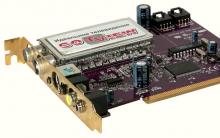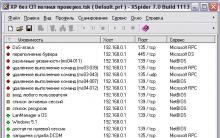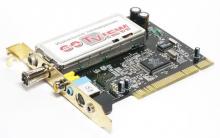Connecting equipment to a computer is accompanied by the mandatory installation of drivers. This article describes how to install a driver for a printer from a disc on a computer or laptop. Since almost all drivers for devices in this category are similar to each other, the installation process is the same.
If you fail to install the printer, then we recommend going down to the bottom of the page and downloading a utility from Microsoft that helps to solve errors related to printers.
- First, disconnect the printer or MFP from the computer and insert the driver disc into the drive. New peripheral equipment must be supplied with a disk with everything necessary for stable operation of a set of programs;
- The inserted disc will immediately launch the installation window due to autorun, so wait a little;
- If the launch did not happen, then go to the "Computer" or "This computer" window through the menu in the Start panel;
- In the window that opens, find the drive icon and open it with a double click;
- On the disk, in addition to all files, there must be a file with the EXE extension in the root folder. Also called Setup or your printer name. Open the file;

- Next, it will either start extracting the files to the folder of your choice, or the installation menu will open. In the first case, after extracting, you must manually start the installation;

Driver installers are similar to each other. Now we will show how to install the HP Deskjet F300 driver, but if you understand the logical chain of driver installation, then you can install any driver on your computer. Therefore, please be careful.
- In the window that opens, click the "Next" button, perhaps you will be immediately asked to install the driver, then click "Install" (if there is a corresponding button). For example, the HP installer;

- During the installation of the drivers, the program may ask you to accept the license agreement. If you refuse, you will not be able to install the driver. Therefore, we agree.

If you are asked to connect the printer to the computer - power and USB cable, then follow these operations. After completing all the steps, wait for the process to complete. If everything went well, then the equipment should work properly and flawlessly.

Other installation methods
If you could not install the drivers manually, then Device Manager will come to your aid. It can be found in the Computer Properties window, which can be opened through the context menu by right-clicking on the computer.


Connect the printer to the PC and update the hardware configuration with the appropriate button in the Manager.

Find the name of the printer in the list and right-click on it. In the menu, select "Update drivers" and click on the button "Search for drivers manually" (2nd item).


In the window that opens, select your computer's drive and click OK.

The Driver Update Wizard will automatically scan the contents of the disk and install all the necessary set of drivers.
Printer problems and solutions
If the drivers did not help to get the printer working properly, a standard Windows tool will help you. It is available in all operating systems, including Windows 10. Go to the "Control Panel" from the Start menu or use the hotkeys "Win" + "X" (if the system is Windows 10). Then go to "View devices and printers". If you do not figure out how to enter here, use the search in Windows.

If the computer recognizes a problem, the printer will be marked with a yellow exclamation mark. Correctly functioning equipment is marked with a green check mark, as in the screenshot.

Removing the printer completely and reinstalling it might fix your problem. To do this, all in the same Devices and Printers window, select the Remove device item from the context menu. Also go to "Uninstall Programs" and see that there is no driver installed for your printer - if you want to remove all drivers.

Then reconnect the printer and install the drivers as described above. If you cannot install the printer, then you can use the search on this site. This will download new drivers for your printer.
There is also a special utility from Microsoft that allows you to fix errors related to printers. We ask you to follow this link and download a program to solve the problem with the printer. Run it, select "Printer" and click "Next".

All tips are applicable for the Windows 10 operating system. This manual is useful for users and other Microsoft operating systems - menus and windows are approximately the same.
Solving the problem related to how to set up a printer to print from a computer is not as difficult as it seems at first glance. Nevertheless, you need to take it competently and seriously, especially for those who like to work in Word and other text editors, who always need to have a printing device at hand.
In order to answer the question of how to install a printer on a computer running Windows OS, you can use two methods. One of them is to connect a printing device directly to a personal computer - the so-called. local method. As for the second method, its use means installing a printing device over a network - the so-called. network method. In general, both methods are relatively simple, but if you do not follow the instructions strictly, you can easily get confused, as a result of which the installation will have to start from the very beginning.
In addition, take into account that the local method makes it possible to use office equipment only on one computer equipment, and the network method - on several personal computers at once, which are connected to one local network.
Method one: local connection
To solve the problem related to how to set up a printer to print from a computer, first you need to establish a reliable and stable connection between your personal computer and the printer using a high-quality USB cable. After that, connect the device to the electrical network. Then follow these steps:
- First of all, open the "Start" menu and click on the section with printing devices.
- In the new window, pay attention to the top panel, where you need to click on the tab that implies the installation of a new printing device.
- Now the installation wizard window should open in front of you, where among the two options you need to click on the topmost one: "Add local".
- In the next step, the wizard will ask you to decide on the optimal port. In general, everything can be left unchanged and click on the existing port: "LPT1". After that click on the "Next" button.
After completing all the steps listed above, start directly configuring the operation of the device connected to the PC. First, you need to install the appropriate software, i.e. driver. To solve this problem, i.e. "How to install drivers", use the CD with the installation file, which comes in one set with the office equipment that you have purchased.
It should be noted that installing the MFP from a disk is more convenient and preferable option.
If you do not have the opportunity to use this installation method, then to solve a problem like "how to install a printer driver", use Windows Update, but at the same time your PC must be connected to the Internet at that moment. It should be added that you can find a driver for your printer model on our website or the official website of its manufacturer.
The third way to install firewood on a new printer connected to a PC is to use the Add Hardware Wizard, where you will need to select the appropriate option for your printing device, and then follow these steps:
- After selecting the manufacturer of your device and its specific name in the wizard window, click on the "Next" button.
- In the next step, the installation wizard will ask you to choose a name for your device. Enter it and click on "Next".
- Now you need to select the options for accessing the printing device from other personal computers. In this case, you need to click either on "Allow sharing ..." or "No sharing ...".
At this point, you can stop installing the device, because the problem of how to set up a printer on a computer has already been solved. Now you just need to check the print to make sure that the device configured for windows 7 is working correctly and your system is able to find it in case of a print task.
To do this, you just need to click on the button that triggers the test page print. It turns out, as a rule, at the last stage of driver installation. Be sure not to forget to put a tick on the "Use by default" item in the same place. It should be added that you can also install the printer on windows 8 using the instructions described above.
Method two: network connection
- To solve a problem related to how to connect a printer to a computer when organizing a local network, first of all, you have to go to the "Start" menu section, where a list of printing devices connected to the PC is displayed.
- In the new window, you should click on the "Add Printer" item and select the lower one among the two options, ie. "Add network, wireless ...".
- The Windows operating system will then automatically search for all printing devices installed and connected to the local network. Thus, the problem is solved, which is associated with how to find a printer.
- As a result of this action, the PC will connect to the device and automatically install the software necessary for it. Thanks to this, you do not need to spend time on this step "how to install drivers on a printer". But sometimes a manual installation is required. In particular, in the window of the installation wizard, "Install drivers" may pop up. To fix the problem, just take and click on this button.
- After that, a message will appear stating that you have successfully installed such and such a printer. Click on "Next".
Thus, the answers to the questions about how to add a printer and how to install a printer have been found. In general, both installing and updating the driver for the printer is not difficult at all and this task does not take so much time, the main thing is to make a test print at the end.
But if the sheet sent for printing did not print, then you should make sure that the addition of a new device was carried out without any restrictions for such a device. The following option is also possible: the equipment intended for printing is simply not connected to the host PC. Also, try updating the installed drivers. To do this, open the properties of the device in the "Devices and Printers" section, then open the "Advanced" tab and click next to the device driver on "Change". The update will then be installed on the PC in automatic mode.
In general, a correctly and correctly installed device should work in absolutely normal mode.
So, half the battle is done. A brand new printer has already been purchased, the only thing left is to connect it to the computer. What could be simpler: connect it to a suitable connector, boot the computer, insert the driver disc into the floppy drive - and that's it ...
But no. You can connect a printer with your own hands, but there are some subtleties here. So let's start all over again.
Install from disk.
1. Take the printer out of the package, carefully detach all protective stickers. Insert the driver disc into the drive. In most cases, autorun will work, a window will appear prompting you to select a region of residence:

For the Canon printer - select the region of residence
(Picture 1)
2. Then the installation options will be offered:

(Figure 2)
If installing the printer is not your daily activity, select "Easy Installation" and move on.
3. We accept and agree to the license agreement:

Click - yes, accepting the license agreement. In some cases, you need to check the box confirming your choice and click - Next.
(Figure 3)
4. We are waiting until the installation program asks to connect the printer:

Printer connection - check if the printer is connected
(Figure 4)
5. Using a connecting cable (you may have to buy it separately - not all printer manufacturers complete their products with it, and not all printers accept cables.) Connect the printer to the computer as shown in the figure.
We are waiting for the end of the installation.
In my practice, there have been cases where it was not possible to install the printer driver from the CD. This usually happened for two reasons: the disc could not be read corny, or the drivers written on it did not fit the operating system installed on the computer. In this case, you had to download the necessary drivers from the Internet.
How to choose the right driver.
To select the correct driver, you need to know the name and model of your printer, and what operating system is installed on your computer.
1. Let's go to: Start / Control Panel / System and Security / System and see the name and type of the system:

(Figure 5)
2. Open the printer manufacturer's website and download the required driver.

(Figure 6)
3. Save it to your hard drive and proceed with installation.
3.1. Let's open the folder with the downloaded file. Click on the icon with the –exe extension, after which the Installation Wizard will start.
3.2. Further, the installation of the printer driver is practically the same as the above algorithm for installation from the CD.
Where can I download / find the drivers I need?
It is best to search for the necessary drivers on the website of the printer or MFP manufacturer. The fact is that there you can find later versions with already fixed errors of previous versions. For hp it is http://www8.hp.com/ru/ru/support-drivers.html, for Canon - http://software.canon-europe.com/. You can also visit the site Driver.ru (http://driver.ru/).
What should I do if I can't install the printer driver the first time?
In this case, the best advice is to disconnect the printer from the computer, uninstall the installed software, carefully read the instructions, find the missing step, and reinstall the printer driver.
Good luck!
Follow these steps to install a local printer. Open the start menu and call the printers and faxes command from it. A window for working with this type of device will appear on the screen. Select Add Printer from the left column of the window. In this case, an additional window for working with the Add Printer Wizard will appear on the screen. Press "Next. On the next page, you must select the printer type local or network. Also, for a local printer, you must specify whether the automatic detection of device parameters will be performed.

Driver Installation
Consider the installation mode, in which the setting of the printer type and its parameters is made by the user. Select the mode of manual installation of a local printer for which uncheck the box and left-click on the first option in the list. Then press the button next. A wizard page will appear on the screen, which specifies the port through which the printer is connected. It can be selected from the list. To do this, open it and click on one of the options. Then press the button next.
A page with a list of all known printers in the system was displayed on the screen. In this case, the name of the printer manufacturer is displayed on the left, and all models are displayed on the right. Select one of the printer models and click Next. If your printer does not appear in the list, you can make settings for it from disk. To do this, click on the Install from disk button. After selecting your printer model, click Next. A page appears where you can enter a name for the printer. In this case, you can use the default ones. By clicking the next button, you will go to the page for setting the sharing parameters of the printer you are installing. Set them and click Next. The system will ask you to print a test page, you can print it by clicking the next button. The last page of the wizard displays all information about the installed printer. Click the done button. And the installation process will be completed.
Into your computer, read the instructions that came with it. Before connecting some printers, you need to install special software, while other printers can be connected immediately.
Turn on your computer and follow the instructions for your printer.
- If your printer is a Plug-and-Play device, plug it in and turn on the power. Windows will take all the necessary steps automatically.
- Insert the disc (s) that came with your printer into the drive and follow the instructions on the screen.
- Execute the command Start> Devices and Printers.
- If you are connecting to a wireless printer, run the command Start> Devices and Printers and in the window that appears, click on the link Setting up the printer... Select an option Add network, wireless or Bluetooth printer and follow the instructions.
If the third option is selected, in the window that appears Devices and Printers click on the link Setting up the printer displayed at the top of the window.
In the Add Printer Wizard (Add Printer dialog box), click Add a local printer and on the button Further.

In the dialog box Select Printer Port, click the down arrow displayed to the right of the box Use an existing port, and select a port. You can also leave the port recommended by Windows. Click on the button Further.

In the next window of the installation wizard - Installing the Printer Driver- select manufacturer and printer. The following options are available:

- If you have a disc from the printer manufacturer, insert it into the appropriate optical disc drive and click the Install from disk... Then click on the button Further.
- If there is no such disk, click on the button Windows Update to view a list of drivers that you can download from the Microsoft website. Then click on the button Further.
- In the dialog box Enter the name of the printer, enter a name for the printer. Click on the button Further.
- In the next dialog box, click on the button Ready to exit the Add Printer Wizard.
If the computer is connected to a network, the installer displays an additional dialog box that allows you to share the printer over the network. Set the switch No printer sharing to prevent other users from accessing this printer. If you want to allow access to this printer, set the switch Allow Printer Sharing so that others can use it in the field Resource name enter the shared name of the printer on the network. In this case, the printer can be used by all users on the network.
Defining the default printer
If you have two or more printers installed on your system, you can define a default printer that will be used whenever you want to print a document. Execute the command Start> Devices and Printers.
In the Devices and Printers window, the current default printer is marked with a check mark. Right-click any non-default printer and select the option from the context menu Use as default... Click on the button Close in the window Devices and Printers after saving the new settings.

To change the properties of the printer model you have, such as the print mode (draft or high quality, color or black and white), right-click on the printer in the window Devices and Printers and in the context menu select the option Printer properties... The Printer Properties dialog box appears.
Removing a Printer
Over time, if you buy a new printer, then the old one can be disconnected from the system. However, you may need to uninstall the old printer driver to clear the window. Devices and Printers from the icon of an old printer that you will most likely never use again. To remove the printer, run the command Start> Devices and Printers.
In the window Devices and Printers right click on the printer and select the option from the context menu Delete device... (Note that you can also highlight the printer and click the button Delete device located at the top of the window Devices and Printers.)

In the dialog box Delete device click the Yes button. Window Devices and Printers will close and your printer will be removed from the list of printers.
If you delete a printer, it will disappear from the list of installed printers, and if it was the default printer, Windows will choose another printer as that. You will no longer be able to print to a printer that was removed from the system unless you reinstall it.
Share.











Valle d'Aosta. Italy. Open left menu Valle d'Aosta Heroes of the Vine
Electrical outlet types and voltages around the world
What are the voltage standards, frequencies and types of outlets in different countries of the world
How the demilitarized zone between North and South Korea has changed
Disable Automatic Updates in Windows